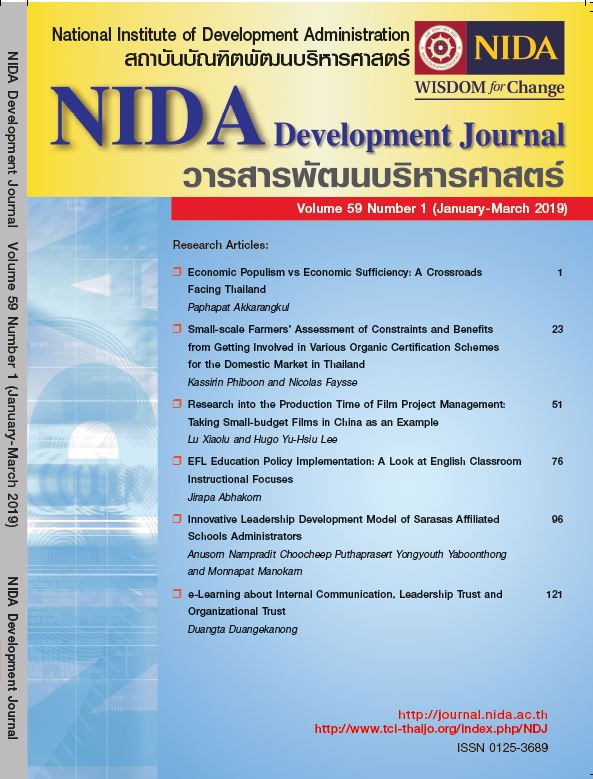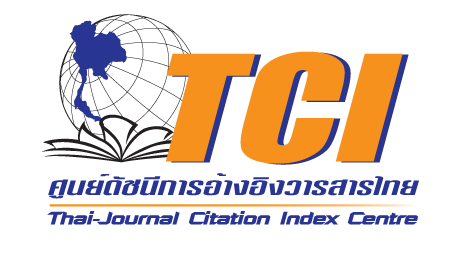Innovative Leadership Development Model Of Sarasas Affiliated Schools Administrators
Keywords:
Development model, Innovative leadership, Sarasas Affiliated Schools AdministratorsAbstract
This research aims to: 1) study the elements and guidelines of innovative leadership development model of Sarasas Affiliated Schools administrators, 2) study the state of innovative leadership of Sarasas Affiliated Schools administrators and 3) create, examine and evaluate innovative leadership development model of Sarasas Affiliated Schools administrators. Research instruments are content synthesis table, connoisseurship record form, teacher questionnaire and administrator interview form. Statistics used in data analysis are mean and standard deviation. Findings reveal that innovative leadership consists of 5 elements: 1) innovative vision and strategies, 2) innovative thinking skills, 3) innovative organization atmosphere creation, 4) risk management and 5) innovative network creation. Innovative leadership development guideline consists of 6 steps: 1) presenting information, 2) individual processing, 3) sharing knowledge for group agreement, 4) presenting innovation for success, 5) criticizing conclusion for action and 6) evaluating the development by indicators. The study results of innovative leadership states of Sarasas Affiliated Schools administrators show a high level in a holistic view. The mean value of innovative organization atmosphere creation is at the lowest. The results of model creation indicate that the elements of the model consist of 6 parts: 1) The Principles of Model, 2) The Objectives of Model, 3) Innovative Leadership Development Process based on Elements and Indicators, 4) Model Success Assessment Guidelines, 5) Success Conditions and 6) Model Application Manual. The results of the examination and evaluation by experts found that, in a holistic view, it was accurate, consistent, appropriate, feasible and useful at the highest level.
References
Carmeli, A., Gelbard, R., & Gefen, D. (2010). The importance of innovative leadership in cultivating strategic fit and enhancing firm performance. The Leadership Quarterly, 21, 339-349. Dansereau.
Chamchoy, Sukanya. (2012). Innovative Concepts for School Administrators in The 21st Century. Journal of Education: Naresuan University, 14(2), 117-127.
Daft, R.L. (2005). The leadership experience. 5th ed. South-Western: Thomson.
Horth, D. & Buchner, D. (2009) Innovative Leadership. Retrieved December 25, 2018, from www.ccl.org/leadership/pdf/research/InnovationLeadership.pdf.
Juito, Saneh. (2011). Innovation Management: New Science of Management. Journal of Modern Management.
Jung, D., C. Chow and A. Wu. (2003). The Role of Transformational Leadership in Enhancing Organizational Innovation: Hypotheses and Some Preliminary Findings. The Leadership Quarterly. 525-544.
Keeves P.J. (1988) Education Research, methodology and measurement: an international handbook. Oxford : Pergamon Press.
Kheowsri, Prasit. (2001). A Proposed Model for Leadership Development of School Administrators in School-based Management Schools. Chulalongkorn University.
Loader, A. (2016). Why should you show innovative leadership? Retrieved from https://blog.castle.co/innovative-leadership.
Madaus, G.F, Scriven, M.,&Stufflebean, D.L. (1983). Evaluation models. Boston: Kluwer-Nijhoff.
Ministry of Education. (2003). National Education Act B.E. 2542 and Amendment (No. 2) B.E. 2545, together with the relevant Ministerial Regulations and Education Act.
Nanus, B. (1992). Visionary leadership: Creating a compelling sense of direction for your organization. San Francisco, CA: Jossey-Bass.
National Innovation Agency. (2004). Innovation Management for Executives. Bangkok: Ministry of Science and Technology.
Office of the Education Council, Ministry of Education. (2017). National Education Plan 2017-2036. Bangkok: Chili Sweet Graphic Co., Ltd.
Phoowittayapan, Apron. (2016). Core Competency Development Program on 70:20:10 Learning Model. Bangkok, Chulalongkorn University.
Pramukkul, Thana. (2004). Review Article. Khon Kaen: Health Promotion Center Region 6.
Robert, F. B., & Jeff, Z. (2010). Leadership vacuums and overcoming barriers to innovation. Retrieved from http://www.business-strategy-innovation.com/2010/04/leadershipvacuums - and overcoming.html.
Rojwattanaboon, Onanong. (2010). Development of An Innovative Leadership Model. Doctoral dissertation in Public Administration, School of Public Administration, National Institute of Development Administration.
Runcharoen, Teera. (2007). Professionalism in Organizing and Administering the Wducation Reform Era (revised edition) for the Second Round of Reform and Third Round for External Assessment. Bangkok: Khaofang Publishing.
Sena, A. & Erena, E. (2012). Innovative Leadership for the Twenty-First Century. Retrieved December 25,2018, from www.sciencedirect.com.
Shama, P. (2008) Innovative Leadership. Retrieved December 5, 2018, from http://www.scribd.com/doc/470597/Innovative-Leadership.
Smith, T. (2004). Innovative leadership. In Encyclopedia of Leadership. Thousand Oaks, CA: Sage Pub.
Stottand. K. & Kong. L.S. (2005). Developing Leadership: Creating the schools of tomorrow. Retrieved December 25, 2018, from http://eds.b.ebscohost.com.
Teacher and Basic Education Personnel Development Bureau. (2007). Developing Change Leaders to Support Decentralization for Educational Administrators and School Administrators. Office of the Basic Education Commission.
Teoprasertkul, Sanchai. (2010). Inner Motivation and Creativity: Things You Must Know (Part 1). Retrieved from https://www.brandage.com.
Thipwaree, Pitak. (2015). A Development Model of Innovative Leadership for Institute of Physical Education Administrators. Prince of Songkla University.
Volk, A. (2012). International Conference on Leadership, Technology and Innovation Management. Retrieved December 25, 2018, from www.sciencedirect.com.
Wuttirong, Payat. (2012). Innovation Management from Concept to Excellence Practice. Bangkok: Chulalongkorn University Press.
Zhang, Y. (2012). Blend Daoism, The Chinese cultural philosophy, with Western leadership theories to enhance innovative capabilities of Chinese enterprises. Retrieved March 28, 2019, from http://search.proquet.com/pqdtglobal.





